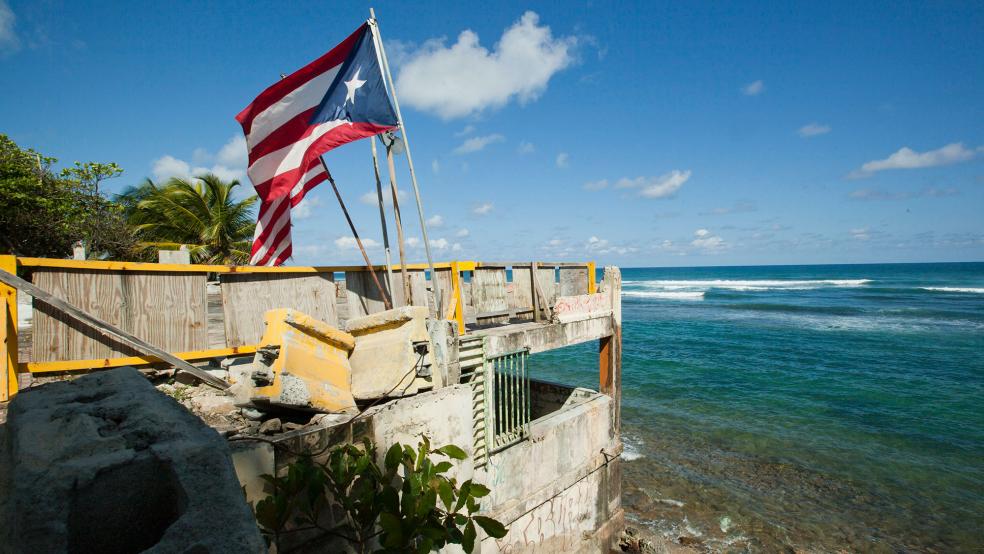There is plenty of blame to go around for Puerto Rico’s fiscal crisis, and it can be directed toward both Washington and San Juan. But at least one cause might surprise you: the New Deal. While most of the New Deal’s nationalized industries and state-run monopolies were wisely rolled-back after the Great Depression, many remain in Puerto Rico, at great cost.
The federal government reacted to the Great Depression by creating an alphabet soup of agencies and government-owned corporations to stimulate and organize economic activity. Although some of this political infrastructure remains, much of it was dismantled after the depression. For example, the Works Progress Administration and the Public Works Administration ended in the 1940s, while the Reconstruction Finance Corporation — created by Hoover but greatly expanded by FDR — was disbanded under Eisenhower.
As the New Deal wound down in Washington, it was just getting started in Puerto Rico. In 1941, President Roosevelt appointed Rexford Tugwell as Governor of Puerto Rico. Tugwell was a Columbia University economist who visited the Soviet Union in 1927. Impressed with the Soviet state’s ability to produce goods and distribute prosperity more broadly, he hoped to bring the benefits of central planning to the United States.
Related: How Hedge Funds Are Profiting From Puerto Rico’s Pain
As a member of FDR’s “brain trust,” Tugwell helped create and implement a number of New Deal programs. These included the Agricultural Adjustment Administration, which paid farmers not to grow food, and the Resettlement Administration, which built planned communities and cooperative farms – an echo of the collective farms in the Soviet Union.
The New Deal Comes to the Caribbean
In Puerto Rico, Tugwell created or expanded a number of public corporations. These included the Water Resources Authority (which later became the Electric Power Authority, PREPA), the Aqueduct and Sewer Authority (PRASA), the Transportation Authority (which later became the Highway and Transportation Authority, PRHTA), the Land Authority and the Government Development Bank (GDB).
Public corporation borrowing began under Tugwell in 1944. The Water Resources Authority issued a $20 million bond to purchase the Porto Rico [sic] Railway, Light and Power Company and the Mayagűez Light, Power and Ice Company, effectively nationalizing most of the island’s electric power supply. Public corporation debt grew rapidly, reaching $50 million in 1947 and almost $100 million by 1952, with both the Transportation Authority and the Aqueduct and Sewer Authority issuing debt.
Today, Puerto Rico’s public corporations owe about $30 billion, dwarfing the commonwealth’s constitutional debt.
Public corporation borrowing was attractive because it allowed Puerto Rico officials to evade debt limits imposed by the federal government. The 1917 Jones-Shafroth Act, still the island’s prevailing law in the 1940s, limited government debt to 7 percent of assessed property valuations and required Puerto Rico’s government to balance revenues and expenditures. By borrowing “off the books” through public corporations, Puerto Rico’s political class could take on far more debt than these limits allowed.
Related: Could Puerto Rico Be Saved by Becoming the 51st State?
Although government debt limits were relaxed under Puerto Rico’s 1952 constitution and a 1961 amendment, public corporations and their borrowing remained attractive. These nationalized entities also persisted amidst the global privatization wave of the 1980s and 1990s started by Margaret Thatcher.
Public vs. Private Debt
When large business enterprises are owned by the government rather than private shareholders, they often underperform due to cronyism and inadequate management incentives. Today, the alphabet soup of Puerto Rico’s state capitalist enterprises embraces water, sewerage, ports, transportation, housing finance, industrial development and banking. If these entities were privatized, many aspects of Puerto Rico’s economy could become more dynamic.
Although state and local governments perform similar functions on the U.S. mainland, it is unusual to see all of these activities handled by the public sector in one place. Government owned corporations on the mainland also borrow, but with a huge difference. The Port Authority of New York and New Jersey, for example, is among the nation’s largest municipal market borrowers, but the authority funds its debt service obligations exclusively from revenues – including airport fees, tolls and rents. Many Puerto Rico public corporations receive commonwealth subsidies, thereby placing at least some of their debt service obligations on taxpayers — both in Puerto Rico and across the United States.
Puerto Rico’s public sector is already heavily dependent on federal subsidies, and this dependence will increase should Congress and the Administration agree on a bailout in early 2016. If Republicans agree to offer more U.S. taxpayer assistance to Puerto Rico, they should condition this support on the privatization of at least some of the commonwealth’s public corporations.
Bondholders should also contribute to privatization in Puerto Rico. When a private company goes bankrupt, bondholders often receive equity in a restructured company in lieu of principal and interest. The same model can and should be applied to Puerto Rico’s public corporations.
Related: Tea Party Revolts Against Obama’s Budget as Debt Exceeds $19 Trillion
Just as Goldman Sachs should not have received one hundred cents on the dollar from taxpayers when AIG was bailed out in 2008, owners of Puerto Rico public corporation debt, including a number of large hedge funds, should not expect a full cash recovery. The ban on Puerto Rico public sector bankruptcies notwithstanding, bond investors had signals of default risk for several years both in the form of low credit ratings and high coupons.
Instead of being given a full recovery at taxpayer expense, bond investors should receive a partial cash settlement plus equity in newly privatized public corporations. Remaining equity should be widely distributed among Puerto Rico residents to increase political support for privatization, and the increased service fees that are likely to accompany it.
Twentieth century experience demonstrated the superiority of competitive, privately-owned companies over state-run monopolies. Now, in the early 21st century, Congress has the opportunity to unravel a remaining thicket of nationalized industries. If Puerto Rico and its bondholders are to receive a bailout, it should at least be accompanied by the long overdue privatization of its New Deal structures.
Marc Joffe is a regular contributor to The Fiscal Times and President of the Center for Municipal Finance. He is also the author of a forthcoming study from the Mercatus Center at George Mason University entitled "Origins of Puerto Rico's Fiscal Crisis."





